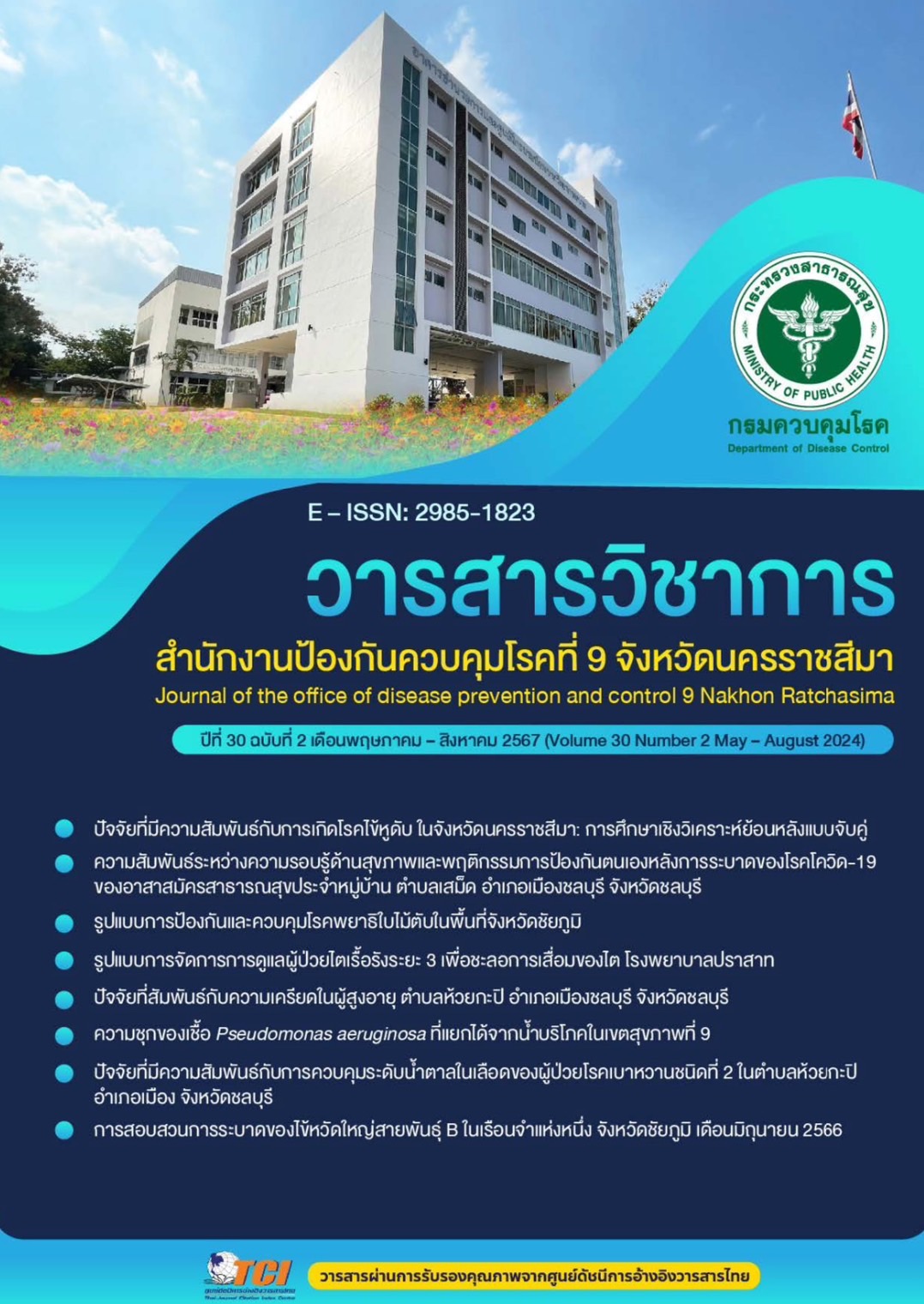ปัจจัยที่มีความสัมพันธ์กับการควบคุมระดับน้ำตาลในเลือดของผู้ป่วยโรคเบาหวานชนิดที่ 2 ในตำบลห้วยกะปิ อำเภอเมือง จังหวัดชลบุรี
คำสำคัญ:
ปัจจัย, การควบคุมระดับน้ำตาลในเลือด, ผู้ป่วยโรคเบาหวานชนิดที่ 2บทคัดย่อ
การวิจัยนี้เป็นการวิจัยเชิงพรรณนาแบบภาคตัดขวาง (Cross-sectional descriptive research) มีวัตถุประสงค์เพื่อศึกษา ความสัมพันธ์ระหว่างปัจจัยส่วนบุคคล ความรู้เกี่ยวกับโรคเบาหวาน และแบบแผนความเชื่อด้านสุขภาพกับการควบคุมระดับน้ำตาลในเลือดของผู้ป่วยโรคเบาหวานชนิดที่ 2 ในตำบลห้วยกะปิ อำเภอเมือง จังหวัดชลบุรี กลุ่มตัวอย่าง ได้แก่ ผู้ป่วยโรคเบาหวานชนิดที่ 2 จำนวน 67 คน เก็บรวบรวมข้อมูลด้วยแบบสอบถาม ประกอบด้วย ปัจจัยส่วนบุคคล ความรู้เกี่ยวกับโรคเบาหวาน แบบแผนความเชื่อด้านสุขภาพ กับการควบคุมระดับน้ำตาลในเลือด และค่า HbA1c จากรายงานทะเบียนการรักษา วิเคราะห์ข้อมูลโดยใช้สถิติเชิงพรรณนาและสถิติเชิงอนุมานวิเคราะห์ความสัมพันธ์ด้วยสถิติไคสแควร์ (Chi-square test) และการวิเคราะห์ถดถอยโลจิสติคแบบทวิ (Binary Logistic Regression) ผลการวิจัย พบว่า อายุและอาชีพ มีความสัมพันธ์กับการควบคุมระดับน้ำตาลในเลือดอย่างมีนัยสำคัญทางสถิติ (p-value = 0.012, 0.010 ตามลำดับ) โดยผู้ที่มีอายุ 35 – 59 ปี และตั้งแต่ 60 ปี ขึ้นไป มีแนวโน้มในการควบคุมระดับน้ำตาลในเลือดให้อยู่ในระดับปกติได้เป็น 1.26 และ 1.88 เท่า ของผู้ที่อายุต่ำกว่า 35 ปี (p-value = 0.039, 0.045 ตามลำดับ) และผู้ที่ไม่ได้ประกอบอาชีพ (แม่บ้าน พ่อบ้าน) มีแนวโน้มในการควบคุมระดับน้ำตาลในเลือดให้อยู่ในระดับปกติได้เป็น 1.37 เท่า ของผู้ที่ประกอบอาชีพ (p-value = 0.038) ส่วนปัจจัยด้านเพศ ระดับการศึกษา สถานภาพ รายได้ ระยะเวลาที่ป่วยเป็นโรคเบาหวาน โรคประจำตัว บุคคลในครอบครัวเป็นโรคเบาหวาน การได้รับข้อมูลข่าวสาร ความสะดวกในการมารับบริการ การตรวจติดตามการรักษา ดัชนีมวลกาย ความรู้เกี่ยวกับโรคเบาหวาน และแบบแผนความเชื่อด้านสุขภาพ การรับรู้โอกาสเสี่ยง การรับรู้ความรุนแรง การรับรู้ประโยชน์ของการปฏิบัติตน และการรับรู้ต่ออุปสรรค พบว่าไม่มีความสัมพันธ์กับการศึกษาดังกล่าว โดยผลการวิจัยครั้งนี้สามารถนำไปส่งเสริมการควบคุมระดับน้ำตาลในเลือดได้ โดยต้องคำนึงถึงอายุและอาชีพของผู้ป่วยโรคเบาหวานชนิดที่ 2 ร่วมด้วย เพราะจะส่งผลให้ผู้ป่วยสามารถดูแลตนเองและควบคุมระดับน้ำตาลในเลือดให้ดีขึ้น
เอกสารอ้างอิง
วิโรจน์ เจียมจรัสรังสี, จมาภรณ์ ใจภักดี, ณัฐนันท์ ทัดพิทักษ์กุล, นิตยาวรรณ กุลณาวรรณ, มารุต บูรณรัช, สุวารีวงศ์โรจนานันท์. โรคเบาหวานชนิดที่2 การป้องกันและการสนับสนุนการจัดการตนเอง. กรุงเทพฯ: จุฬาลงกรณ์มหาวิทยาลัย; 2561.
สมาคมโรคเบาหวานแห่งประเทศไทย. แนวทางเวชปฏิบัติสำหรับโรคเบาหวาน พ.ศ. 2560. พิมพ์ครั้งที่ 3. ปทุมธานี: ร่มเย็นมีเดีย; 2560.
วิชัย เอกพลากร. โรคเบาหวาน. ใน: วิชัย เอกพลากร, บรรณาธิการ. การสำรวจสุขภาพประชาชนไทยโดยการตรวจร่างกายครั้งที่ 5. นนทบุรี: สถาบันวิจัยระบบสาธารณสุข; 2557. หน้า 141-148.
สำนักงานนโยบายและยุทธศาตร์ กระทรวงสาธารณสุข. ข้อมูลสถานสุขภาพโรคเบาหวาน [อินเตอร์เน็ต]. 2564 [เข้าถึงเมื่อ 2565 กันยายน 1]. เข้าถึงได้จาก: http://hdc2.cbo.moph.go.th/hdc/reports/report.php?source=formatted.
อภิวันท์ เจริญวัฒน์. การศึกษาปัจจัยที่มีผลต่อการควบคุมระดับน้ำตาลในเลือดของผู้ป่วยเบาหวานชนิดที่ 2 ที่เข้ารับการรักษาในสถานีอนามัยเฉลิมพระเกียรติ 60 พรรษา นวมินทราชินี คลองมะสง อำเภอไทรน้อย จังหวัดนนทบุรี. วารสารสมาคมเวชศาสตร์ป้องกันแห่งประเทศไทย. 2561;8(3):441-449.
ปิยะวดี ทองโปรง. ปัจจัยที่มีความสัมพันธ์กับการควบคุมระดับน้ำตาลในเลือดของผู้ป่วยเบาหวานชนิดที่สองของชุมชนแหงหนึ่งในจังหวัดอุบลราชธานี. วารสารราชธานีนวัตกรรมทางวิทยาศาสตร์สุขภาพ มหาวิทยาลัยราชธานี. 2561;2(4):9-22.
สุวัฒน์ ศิริแก่นทราย. ความเชื่อด้านสุขภาพที่มีความสัมพันธ์กับการควบคุมระดับน้ำตาลในเลือดของผู้ป่วยเบาหวานชนิดที่ 2 ตำบลกุดจิก อำเภอเมือง จังหวัดหนองบัวลำภู. วารสารวิชาการเซาธ์อีสท์บางกอก. 2562;5(1):55-68.
Becker M.H., Maiman L.A. Sociobehavioral Determinants of Compliance with Health and medical Care Recommendation. Medical Care. 1975;13:10-24.
Daniel W.W.,Cross C.L. Biostatistics: A Foundation for Analysis in the Health Sciences. 10th ed. New York: John Wiley & Sons Inc; 2013.
Bloom B.S., Madaus G.F., Hastings J.T. Hand book on Formative and Summative Evaluation of Student Learning. New York: Mc Graw-Hill Book Company; 1971.
Best J.W. Research in Education. New Jersey: Prentice Hall Inc; 1977.
เทพ หิมะทองคำ และคณะ. ความรู้เรื่องเบาหวานฉบับสมบูรณ์. พิมพ์ครั้งที่ 3. กรุงเทพฯ: จูน พับลิซซิ่ง; 2557.
Azzam MM, brahim AA, El-Ghany MA. Factors affecting glycemic control among Egyptian people with diabetes attending primary health care facilities in Mansoura District. The Egyptian Journal of Internal Medicine. 2021;33:1-10.
Melkamu L., Berhe R., Handebo S. Does Patients’ Perception Affect Self-Care Practices? The Perspective of Health Belief Model. Dovepress. 2021;23:2145-2154.

ดาวน์โหลด
เผยแพร่แล้ว
รูปแบบการอ้างอิง
ฉบับ
ประเภทบทความ
สัญญาอนุญาต
ลิขสิทธิ์ (c) 2024 สำนักงานป้องกันควบคุมโรคที่ 9 จังหวัดนครราชสีมา

อนุญาตภายใต้เงื่อนไข Creative Commons Attribution-NonCommercial-NoDerivatives 4.0 International License.
บทความที่ลงพิมพ์ในวารสารวิชาการสำนักงานป้องกันควบคุมโรคที่ 9 จังหวัดนครราชสีมา ถือว่าเป็น
ลิขสิทธิ์ สำนักงานป้องกันควบคุมโรคที่ 9 จังหวัดนครราชสีมา



